Circles Class 10 MCQ is one of the best strategies to prepare for the CBSE Class 10 Board exam. If you want to complete a grasp concept or work on one’s score, there is no method except constant practice. Students can improve their speed and accuracy by doing more MCQ on Circles class 10, which will help them all through their board test.
Circles Class 10 MCQ Questions with Answers
Class 10 Math MCQ with answers are given here to chapter 10 Circles . These MCQs are based on the latest CBSE board syllabus and relate to the latest Class 10 Mathematics syllabus. By Solving these Class 10 MCQs, you will be able to analyze all of the concepts quickly in the chapter and get ready for the Class 10 Annual exam.
Learn Circle Class 10 MCQ with answers pdf free download according to the latest CBSE and NCERT syllabus. Students should prepare for the examination by solving CBSE Class 10 Mathematics Quadratic Equation MCQ with answers given below.
Question 1. What is the number of common tangents that can be drawn to two intersecting circles touching at two points?
(a) 2
(b) 4
(c) 3
(d) 1
Ans.
A
Question 2. AP is a secant and PT is a tangent to a circle. Lf PT=15cm and AB = 8BP, find AP.

(a) 45 cm
(b) 36 cm
(c) 25 cm
(d) 62 cm
Ans.
A
Question 3. In ΔABC, ∠B = 90° .If a circle drawn with AB as diameter intersects the hypotenuse AC at P, which of the following is true?
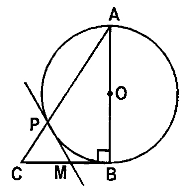
(a) The tangent drawn to the circle at P bisects the side BC.
(b) The tangent drawn to the circle at A bisects the side AB.
(c) The tangent drawn to the circle at B bisects the side AC.
(d) The tangent drawn to the circle at C bisects the side BC
Ans.
A
Question 4. PT is a tangent and PAB is a secant of the circle meeting the circle at A and B. If PA = 4 cm and AB = 5 cm. What is the length of PT?
(a) 8 cm
(b) 6 cm
(c) 3 cm
(d) 1 cm
Ans.
B
Question 5. In the given figure, 0 is the centre of the circle. PQ is the tangent to the circle and secant PAB passes through the centre O.

If PQ =5 cm and PA = 1 cm, find the radius of the circle.
(a) 8cm
(b) 12cm
(c) 10cm
(d) 6cm
Ans.
B
Question 6. A circle with centre 0 and radius 5 cm is inscribed in an equilateral triangle ABC.
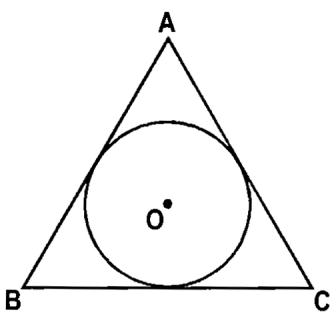
Find the perimeter of ΔABC.
(a) 15√3cm
(b) 25√2 cm
(c) 14√2 cm
(d) 30√3cm
Ans.
D
Question 7. A tangent ST at P to a circle at P is parallel to a chord QR of the circle.

Which of the following is correct statement?
(a) P is equidistant from the extremities of the chord.
(b) PT is the tangent parallel to the chord PQ.
(c) PT is the tangent parallel to the cord PR.
(d) S is equidistant from the extremities of the chord.
Ans.
A
Question 8. An isosceles triangle in which AB = AC is inscribed in a circle.

Which of the following is true?
(a) Tangent at A is parallel to BC.
(b) Tangent at A is perpendicular to AB.
(c) Tangent at A is parallel to AC.
(d) Tangent at A is perpendicular to BC.
Ans.
A
Question. 9 Tangents AP and AQ are drawn to a circle with centre 0 from an external point A.

Identify the correct statement.
(a) ∠PAQ = 2 ∠OPQ
(b) ∠PAQ = ∠OPQ
(c) ∠PQA = ∠QPA
(d) ∠PQA = 2 ∠OPA
Ans.
B
Question 10. BD and CD are two tangents drawn to a circle with centre O.
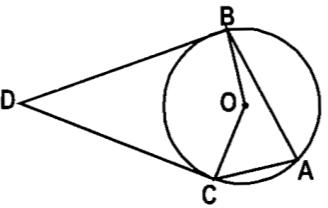
If ∠BDC = 44° ,find ∠BAC.
(a) 68°
(b) 32°
(c) 44°
(d) 96°
Ans.
A
Question 11. With the vertices of a ΔABC as centres, three circles are described, each touching the other two externally. If the sides of the triangle are 9 cm, 7 cm and 6 cm, find the radii of the circles.

(a) 4 cm, 7 cm and 3 cm
(b) 7 cm, 5 cm and 2 cm
(c) 5 cm, 4 cm and 3 cm
(d) 4 cm, 5 cm and 2 cm
Ans.
D
Question. 12 If ∠APO = 18°, find ∠AOB.
(a) 24°
(b) 144°
(c) 108°
(d) 1 75°
Ans.
B
Question 13. In the given figure, ABCD is a quadrilateral in which ∠Q = 90° . A circle C (O, r) touches the sides AB, BC, CD and DA at P, Q, R, S respectively. If BC = 38 cm, CD = 25 cm, and BP = 27 cm, find the value of r.

(a) 14cm
(b) 15cm
(c) 10cm
(d) 16cm
Ans.
A
Question 14. In the above question (no. 3) what is the ratio of AM : BM?
(a) 5 : 6
(b) 3 : 2
(c) 1 : 1
(d) can’t be determined
Answer
C
Question 15. In the given figure, ABCD is a cyclic quadrilateral and AB is the diameter. ÐADC = 140°, then find m ÐBAC:

(a) 45°
(b) 40°
(c) 50°
(d) none of the above
Answer
C
Question 16. PQ is a chord of a circle .the tangent XR at X on the circle cuts PQ produced at R. If XR = 12 cm , PQ = x cm, QR = (x – 2)cm , find x in cm.
(a) 6
(b) 7
(c) 10
(d) 14
Ans.
C
Question 17. In the given figure, ABC is an isosceles triangle in which AB = AC.A circle through B touches AC at its mid-point D and intersects AB at P.

Ans.
D
Question 18. In the given figure the two chords AC and BC are equal. The radius OC intersect AB at M, then AM : BM is :

(a) 1 : 1
(b) √2 : 3
(c) 3 : 2
(d) none of the above
Answer
A
Question 19. In the adjoining figure, O is the centre of circle and diameter AC = 26 cm. If chord AB = 10 cm, then the distance between chord AB and centre O of the circle is :

(a) 24 cm
(b) 16 cm
(c) 12 cm
(d) none of the above
Answer
C
Question 20. DABC and DDBC have a common base and drawn towards one sides. ÐBAC = ÐBDC = 60°. If AC and DB intersect at P, then :
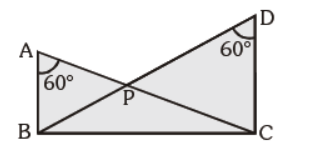
(a) AP × PC = BP × PD
(b) AP × BP = PC × PD
(c) AP × PD = PC × BP
(d) none of these
Answer
A
Question 21. The quadrilateral formed by angle bisectors of a cyclic quadrilateral is a:
(a) rectangle
(b) square
(c) parallelogram
(d) cyclic quadrilateral
Answer
D
Question 22. In the given figure, ÐAOC = 120°. Find m ÐCBE, where O is the centre:
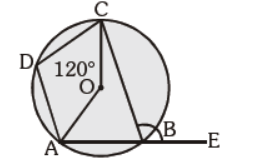
(a) 60°
(b) 100°
(c) 120°
(d) 150°
Answer
C
Question 23. If the diagonals of a cyclic quadrilateral are equal, then the quadrilateral is
(a) rhombus
(b) square
(c) rectangle
(d) none
Answer
C
Question 24. In the adjoining figure, O is the centre of the circle and ÐOBD = 50°. Find the m ÐBAD:
(a) 60°
(b) 40°
(c) 80°
(d) 45°
Answer
B
Question 25. In the adjoining circle C (O, r) the degree measure of minor arc AB = 130°. Find the degree measure of major arc :

(a) 230°
(b) 260°
(c) 310°
(d) none of the above
Answer
A
Question 26. In the given figure, ABCD is a cyclic quadrilateral and diagonals bisect each other at P. If ÐDBC = 60° and ÐBAC = 30°, then ÐBCD is :
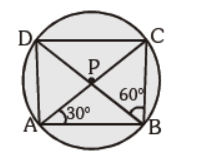
(a) 90°
(b) 60°
(c) 80°
(d) none of the above
Answer
A
Question 27. In the given figure, O is the centre of the circle. Radius of the circle is 17 cm. If OC = 8 cm, then the length of the chord AB is :

(a) 35 cm
(b) 30 cm
(c) 15 cm
(d) 18 cm
Answer
B
Question 28. In the given figure, ÐBAC and ÐBDC are the angles of same segments. ÐDBC = 30° and ÐBCD = 110°. Find m ÐBAC is :

(a) 35°
(b) 40°
(c) 55°
(d) 60°
Answer
B
Question 29. In the given figure, AB is diameter of the circle. C and D lie on the semicircle. ÐABC = 65° and ÐCAD = 45°. Find m ÐDCA.

(a) 45°
(b) 25°
(c) 20°
(d) none of these
Answer
C
Question 30. In the given figure, AB is the diameter of the circle. Find the value of ÐACD :

(a) 30°
(b) 60°
(c) 45°
(d) 25°
Answer
C
Question 31. In the given figure, two circles with their respective centres intersect each other at A and B and AB intersects OO’ at M, then m ÐOMA is :

(a) 60°
(b) 80°
(c) 90°
(d) Can’t be determined
Answer
C
Question 32. In the given figure, DABC is an equilateral triangle. Find m ÐBEC:

(a) 120°
(b) 60°
(c) 80°
(d) none of the above
Answer
A
Question 33. In the given figure OM ^ AB, radius of the circle is 5 cm and length of the chord AB = 8 cm. Find the measure of OM :
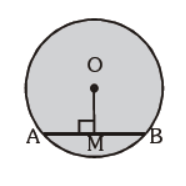
(a) 3 cm
(b) 2.5 cm
(c) 2 cm
(d) 6 cm
Answer
A
Question 34. In the given figure, O is the centre of the circle and, ÐAOB = 100°. Find m ÐBCD :

(a) 80°
(b) 60°
(c) 50°
(d) 40°
Answer
C
Question 35. In the given figure, O is the centre of the circle. ÐAOB = 70°, find m ÐOCD :

(a) 70°
(b) 55°
(c) 65°
(d) 110°
Answer
B
Question 36. In the given figure, chords AB and CD are equal. If ÐOBA = 55° , then m ÐCOD is:

(a) 65°
(b) 55°
(c) 70°
(d) 50° A
Answer
C
Question 37. In the given figure, O is the centre of the circle. ÐABO = 60°. Find the value of ÐACB :

(a) 40°
(b) 60°
(c) 50°
(d) 30°
Answer
D
Question 38. In the given figure, AB is the diameter, m ÐBAD = 70° and m ÐDBC = 30°. Find m ÐBDC

(a) 25°
(b) 30°
(c) 40°
(d) 60°
Answer
C
Question 39. In the given figure, O is the centre of the circle and ÐACB = 25°. Find ÐAOB :

(a) 25°
(b) 50°
(c) 75°
(d) 60°
Answer
B
Question 40. In the given figure, ABC is an isosceles triangle in which AB = AC and m ÐABC = 50°, m ÐBDC:

(a) 80°
(b) 60°
(c) 65°
(d) 100°
Answer
A
Question 41. The line AB is 6 m in length and is tangent to the inner one of the two concentric circle at point C. It is known that the radii of the two circles are integers. The radius of the outer circle.

(a)5 m
(b) 4 m
(c) 6 m
(d) 3 m
Answer
A
Question 42. Find the distance of a perpendicular from the centre of a circle to the chord if the diameter of the circle is 30 cm and its chord is 24 cm.
(a) 6 cm
(b) 7 cm
(c) 9 cm
(d) 10 cm
Answer
C
Whoever needs to take the CBSE Class 10 Board Exam should look at this MCQ. To the Students who will show up in CBSE Class 10 Mathematics Board Exams, It is suggested to practice more and more questions. Aside from the sample paper you more likely had solved. These Circles Class 10 MCQ are ready by the subject specialists themselves.
Question 43. Find the value of ÐDCE :

(a) 100°
(b) 80°
(c) 90°
(d) 75°
Answer
B
Question 44. AB and CD are two parallel of a circle such that AB=10 cm and CD = 24 cm. The chords are on opposite sides of the centre and the distance between them is 17 cm. Find the radius of the circle
(a) 11 cm
(b) 12 cm
(c) 13 cm
(d) 14 cm
Answer
C
Question 45. In the given figure, ÐCAB = 40° and ÐAKB = 105°. Find ÐKCD :

(a) 65°
(b) 35°
(c) 40°
(d) 72°
Answer
B
Question 46. In the given figure, APB is tangent, ÐQPS = 80°, ÐPSQ=65° and ÐSQR = 25°, then

(a) ÐSPB = 35°
(b) ÐAPQ = 65°
(c) ÐQSR = 55°
(d) all of these
Answer
D
Question 47. The radii of two concentric circles are 13 cm and 8 cm. AB is a diameter of bigger circle. BD is a tangent to the smaller circel touching it at D. Find the length of AD.
(a) 15 cm
(b) 16 cm
(c) 18 cm
(d) 19 cm
Answer
D
Question 48. In the given figure, O is the centre of the circle. ÐAOB = 90°. Find m ÐAPB :

(a) 130°
(b) 150°
(c) 135°
(d) can’t be determined
Answer
C
Question 49. O and O’ are the centres of two circles which touch each other externally at P. AB is a common tangent. Find ÐAPO:
(a) 90°
(b) 120°
(c) 60°
(d) data insufficient
Answer
A
Question 50. In the given figure, there are two circles with the centres O and O’ touching each other internally at P. Tangents TQ and TP are drawn to the larger circle and tangents TP and TR are drawn to the smaller circle. Find TQ : TR

(a) 8 : 7
(b) 7 : 8
(c) 5 : 4
(d) 1 : 1
Answer
D
Question 51. In the given figure, O is the centre of the circle. AB is tangent. AB = 12 cm and OB = 13 cm. Find OA:

(a) 6.5 cm
(b) 6 cm
(c) 5 cm
(d) none of these
Answer
C
Question 52. In the given figure, PQ is the tangent of the circle. Line segment PR intersects the circle at N and R.
PQ = 15 cm, PR = 25 cm, find PN
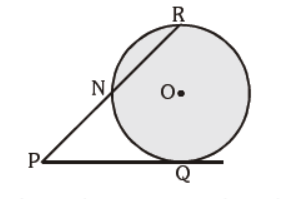
(a) 15 cm
(b) 10 cm
(c) 9 cm
(d) 6 cm
Answer
C
Question 53. ABCD is a cyclic quadrilateral PQ is a tangent at B. If ÐDBQ = 65° , then ÐBCD is :

(a) 35°
(b) 85°
(c) 115°
(d) 90°
Answer
C
Question 54. In the given figure, tangent PT = 5 cm, PA = 4 cm, find AB :

(a) 7/ 4 cm
(b) 11/ 4 cm
(c) 9/ 4cm
(d) can’t be determined
Answer
C
Question 55. In the given figure, PAQ is the tangent. BC is the diameter of the circle. m ÐBAQ = 60°, find m ÐABC

(a) 25°
(b) 30°
(c) 45°
(d) 60°
Answer
B
Question 56. In the given figure, AP = 3 cm, BA = 5 cm and CP = 2 cm. Find CD :

(a) 12 cm
(b) 10 cm
(c) 9 cm
(d) 6 cm
Answer
B
Question 57. In the given figure, AP = 2 cm, BP = 6 cm and CP = 3 cm. Find DP :

(a) 6 cm
(b) 4 cm
(c) 2 cm
(d) 3 cm
Answer
B
Question 58. ‘O’ is the centre of the circle, line segment BOD is the angle bisector of ÐAOC, m ÐCOD = 50°. Find m ÐABC:

(a) 25°
(b) 50°
(c) 100°
(d) 120°
Answer
B
Question 59. Two circles of radii 13 cm and 5 cm touch internally each other. Find the distance between their centres
(a) 18 cm
(b) 12 cm
(c) 9 cm
(d) 8 cm
Answer
D
Question 60. An equilateral triangle has side 2 3 cm. The radius of its circumcircle will be
(a) 2 cm
(b) 3 cm
(c) 3 cm
(d) 4 cm
Answer
A
Question 61. In the given figure, AB is the diameter of the circle. ÐADC = 120°, Find m ÐCAB.

(a) 20°
(b) 30°
(c) 40°
(d) Can’t be determined.
Answer
B
Question 62. In the given figure, O is the centre of the circle and ÐAOC = 100°. Find the ratio of m ÐADC : m ÐABC

(a) 5 : 6
(b) 1 : 2
(c) 5 : 13
(d) None of the above
Answer
C
Question 63. Three circles touch each other externally. The distance between their centre is 5 cm, 6 cm and 7 cm. Find the radii of the circles :
(a) 2 cm, 3 cm, 4 cm
(b) 3 cm, 4 cm, 1 cm
(c) 1 cm, 2.5 cm, 3.5 cm
(d) 1 cm, 2 cm, 4 cm
Answer
A
Question 64. In the given figure, O is the centre of circle. ÐAOB = 80° and ÐAOC = 120°. Find m ÐBAC :

(a) 120°
(b) 80°
(c) 100° C
(d) None of the above
Answer
B
Question 65. A circle touches a quadrilateral ABCD. Find the true statement:

(a) AB + BC = CD + AD
(b) AB + CD = BC + AD
(c) BD = AC
(d) none of the above
Answer
B
Question 66. In the given fig. PQ is a tangent to the circle at A, ÐBAQ = 50° and ÐBAC = 35°, then ABC=

(a) 50°
(b) 35°
(c) 85°
(d) 95°
Answer
D
Question 67. In the adjoining figure, PQRS is a cyclic quadrilateral and the sides PS and QR are produced to meet at B. Then out of the following the true statement is

(a) PR= QS
(b) PB=QB
(c) PR=QB
(d) none of these
Answer
B
Question 68. In a circle of radius 5 cm, AB and AC are the two chords such that AB = AC = 6 cm. Find the length of the chord BC.
(a) 4.8 cm
(b) 10.8 cm
(c) 9.6 cm
(d) none of these
Answer
C
Question 69. AB is the chord of a circle with centre O. AB is produced to C, such that BC = OB. CO is joined and produced to meet the circle in D. If ÐACD=y° and ÐAOD = x°, then

(a) 3x°=y°
(b) x°=3y°
(c) x°=y°
(d) x°=4y°
Answer
B
Question 70. In the given figure, ÐCOB = 40°, AB is the diameter of the circle. Find m ÐCAB:

(a) 40°
(b) 20°
(c) 30°
(d) None of these
Answer
B
Question 71. A circle has two parallel chords of lengths 6 cm and 8 cm. If the chords are 1 cm apart and the centre is on the same side of the chords, then a diameter of the circle is of length:
(a) 5 cm
(b) 6 cm
(c) 8 cm
(d) 10 cm
Answer
D
Question 72. In a circle of radius 17 cm, two parallel chords are drawn on opposite sides of a diameter. The distance between the chords is 23 cm. If the length of one chord is 16 cm, then the length of the other is :
(a) 23 cm
(b) 30 cm
(c) 15 cm
(d) none of these
Answer
B
Question 73. In the given figure, AB and CD are two common tangents to the two touching circles. If CD = 6 cm, then AB is equal to:

(a) 9 cm
(b) 15 cm
(c) 12 cm
(d) none of the above
Answer
C
Question 74. Through any given set of four points P,Q, R, S it is possible to draw :
(a) atmost one circle
(b) exactly one circle
(c) exactly two circles
(d) exactly three circles
Answer
A
Question 75. O and O’ are the centres of circle of radii 20 cm and 37 cm. AB = 24 cm. What is the distance OO’?

(a) 51 cm
(b) 45 cm
(c) 35 cm
(d) 48 cm
Answer
A
Question 76. In a circle of radius 5 cm, AB and AC are two chords such that AB=AC=6 cm. The distance of the chord BC from centre is

(a) 3.6 cm
(b) 1.4 cm
(c) 1 cm
(d) 4 cm
Answer
B
Question 77. Three equal circles of unit radius touch each other. Then, the area of the circle circumscribing the three circles is :
(a) 6π (2 +√3 )2
(b) 6/π ( 2+√3)2
(c) π/3 (2+√3)2
(d) 3π(2+√3)2
Answer
C
Question 78. ABC is a right angled triangle AB = 3 cm, BC = 5 cm and AC = 4 cm, then the inradius of the circle is C 5cm 4cm A B 3cm

(a) 1 cm
(b) 1.25 cm
(c) 1.5 cm
(d) none of these
Answer
A
Question 79. The number of common tangents that can be drawn to two given circles is at the most :
(a) 1
(b) 2
(c) 3
(d) 4
Answer
B
Question 80. In the fig, RTP and STQ are common tangents to the two circels with centres A and B. The radii of the two circles are 3 cm and 5 cm respectively. If ST : TQ = 1 : 3 and RT = 4 cm. Find the length of QT and AB.

(a) 11 cm, 12 cm
(b) 12 cm, 18 cm
(c) 18 cm, 12 cm
(d) 12 cm, 15 cm
Answer
B
Question 81. The chord ED is parallel to the diameter AC, as shown in the figure. The ___ magnitude of ÐCED is equal to

(a) 30°
(b) 40°
(c) 50°
(d) 60°
Answer
B
Question 82. In the diagram, PQ and QR are tangents to the circle centre O, at P and R respectively. Find the value of

(a) 25
(b) 35
(c) 45
(d) 55
Answer
C
Question 83. In the fig., PQ is a tangent to the circle at P. QRS is a straight line. Find the value of x.

(a) 25°
(b) 30°
(c) 35°
(d) 40°
Answer
D
Question 84. In the given figure, CD is a direct common tangent to two circles intersecting each other at A and B, then: ÐCAD + ÐCBD = ?

(a) 120°
(b) 90°
(c) 360°
(d) 180°
Answer
D
Question 85. If AB is a chord of a circle, P and Q are two points on the circle different from A and B, then:
(a) the angle subtended by AB at P and Q are either equal or supplementary.
(b) the sum of the angles subtended by AB at P and Q is always equal two right angles.
(c) the angles subtended at P and Q by AB are always equal.
(d) the sum of the angles subtended at P and Q is equal to four right angles.
Answer
A
You can easily get good marks If you study with the help of Class 10 Circles MCQ. We trust that information provided is useful for you. NCERT MCQ Questions for Class 10 Circles PDF Free Download would without a doubt create positive results.
We hope the information shared above in regards to MCQ on Circles Class 10 with Answers has been helpful to you. if you have any questions regarding CBSE Class 10 Mathematics Solutions MCQs Pdf, write a comment below and we will get back to you as soon as possible.
Frequently Asked Question (FAQs)
How many MCQ questions are there in Class 10 Chapter 10 Mathematics?
In Class 10 chapter 10 Mathematics, we have provided 85 Important MCQ Questions, But in the future, we will add more MCQs so that you can get good marks in the Class 10 exam.
Can we score good marks in Class 10 Mathematics with the help of Circles MCQ Questions?
Yes, MCQ Question is one of the best strategies to make your preparation better for the CBSE Board Exam. It also helps to know the student’s basic understanding of each chapter. So, You can score good marks in the Class 12 Mathematics exam.